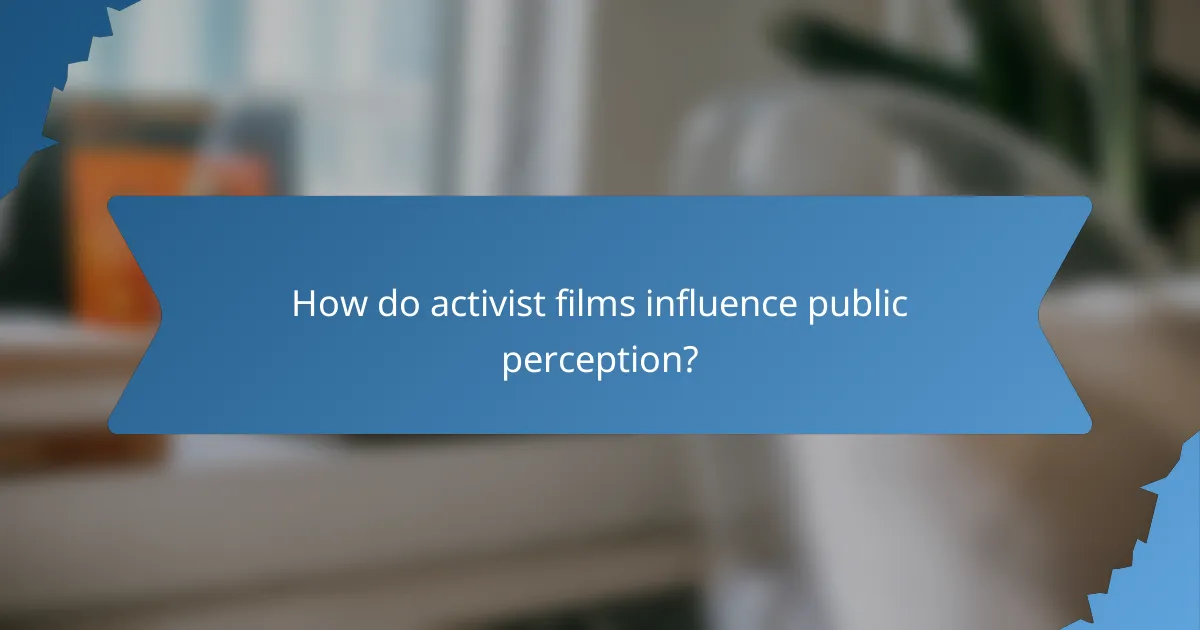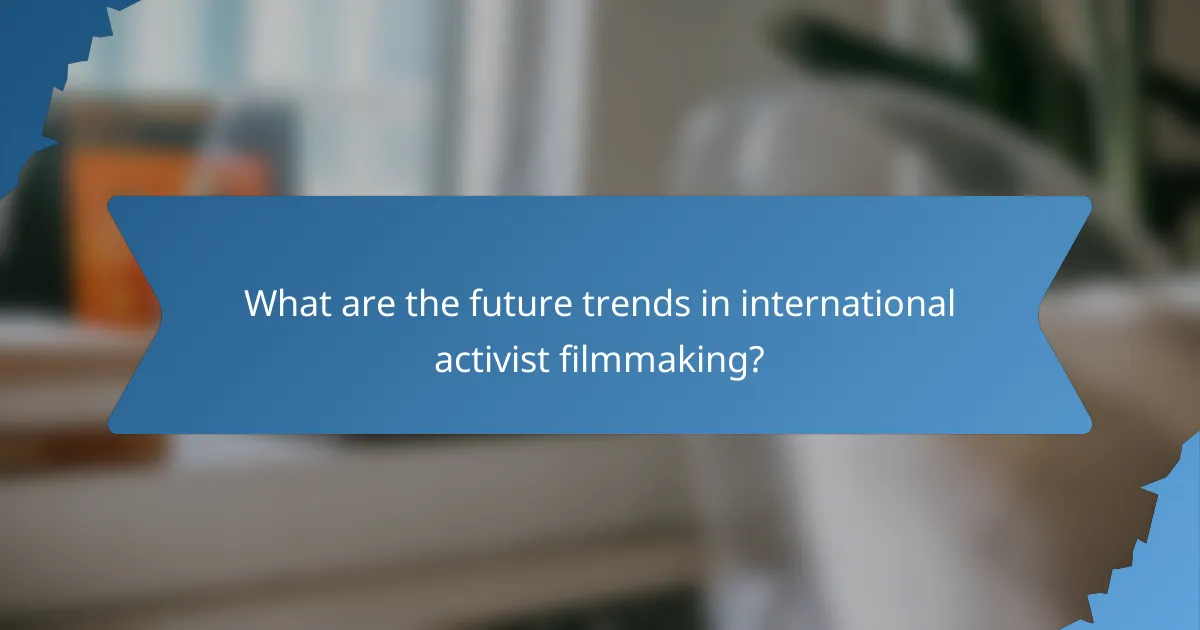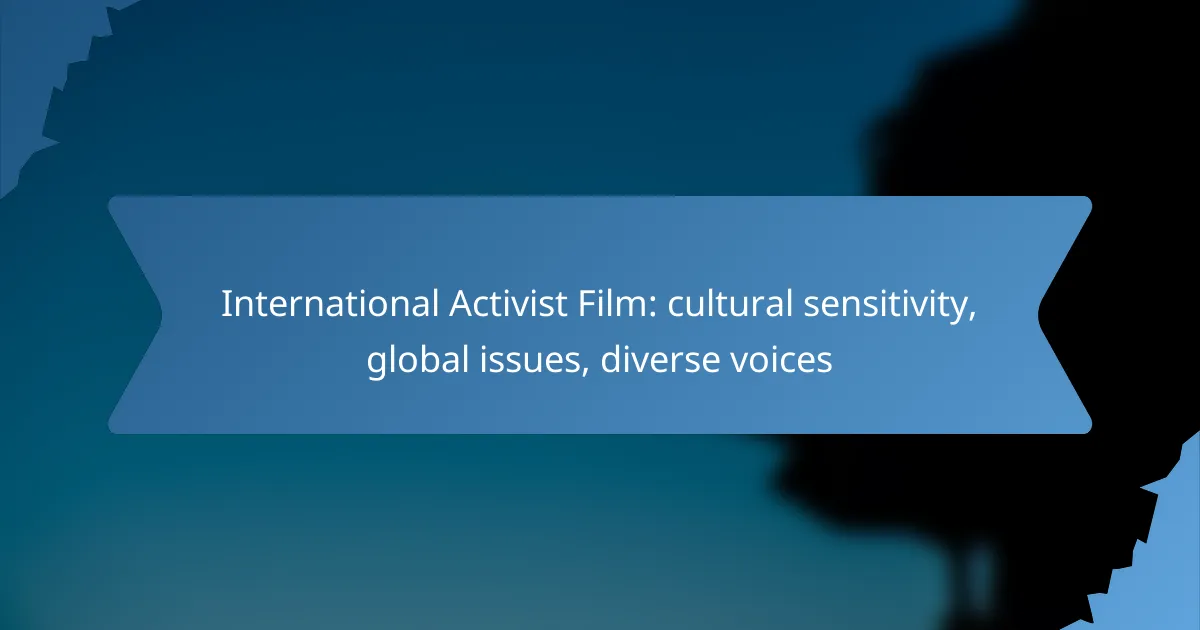International activist films play a crucial role in promoting cultural sensitivity by highlighting diverse voices and experiences. By addressing pressing global issues such as climate change and human rights, these films foster empathy and understanding, encouraging audiences to engage with the world around them. Through their storytelling, they amplify the perspectives of marginalized communities, inspiring action and awareness on critical social justice matters.

How can international activist films address cultural sensitivity?
International activist films can effectively address cultural sensitivity by portraying diverse perspectives and experiences while respecting the cultures represented. This approach fosters understanding and empathy, allowing audiences to engage with global issues in a meaningful way.
Representation of diverse cultures
Accurate representation of diverse cultures is crucial in international activist films. Filmmakers should strive to depict the complexities of different societies, avoiding stereotypes and simplistic narratives. This can involve showcasing a variety of voices, traditions, and languages to reflect the richness of the cultures being portrayed.
For instance, a film set in Southeast Asia might include local dialects and customs, providing authenticity and depth. Engaging cultural consultants can help ensure that the representation is respectful and accurate, enhancing the film’s credibility.
Ethical storytelling practices
Ethical storytelling practices are essential for maintaining cultural sensitivity in activist films. Filmmakers should prioritize transparency and honesty in their narratives, ensuring that the stories told are not exploitative. This means being mindful of the power dynamics involved in storytelling and striving for a balanced portrayal of the subjects.
Additionally, filmmakers should consider the potential impact of their work on the communities depicted. This includes being aware of how narratives may reinforce or challenge existing stereotypes and ensuring that the stories contribute positively to the discourse surrounding the issues at hand.
Collaboration with local communities
Collaborating with local communities is a key strategy for fostering cultural sensitivity in international activist films. By involving community members in the filmmaking process, filmmakers can gain valuable insights and perspectives that enhance the authenticity of the narrative. This collaboration can take various forms, such as co-writing scripts or involving locals in production roles.
Moreover, such partnerships can empower communities by giving them a platform to share their stories on their terms. This not only enriches the film but also helps build trust and respect between filmmakers and the communities they represent, ultimately leading to a more impactful and sensitive portrayal of global issues.

What global issues do activist films highlight?
Activist films often focus on pressing global issues such as climate change, human rights violations, and social justice movements. These films aim to raise awareness, provoke thought, and inspire action among viewers by showcasing diverse perspectives and experiences.
Climate change awareness
Climate change awareness is a central theme in many activist films, emphasizing the urgent need for action to combat environmental degradation. These films often illustrate the impact of climate change on vulnerable communities, highlighting issues like rising sea levels, extreme weather events, and biodiversity loss.
For example, documentaries may showcase the struggles of communities facing displacement due to flooding or the effects of drought on agriculture. By presenting these narratives, filmmakers aim to motivate audiences to engage in sustainable practices and advocate for policy changes.
Human rights violations
Human rights violations are a critical focus of activist films, which often document injustices faced by marginalized groups around the world. These films shed light on issues such as political repression, discrimination, and violence against individuals based on their identity or beliefs.
By portraying real-life stories of victims and activists, these films seek to foster empathy and encourage viewers to support human rights initiatives. They may also call attention to international laws and treaties designed to protect individuals, urging audiences to hold governments accountable.
Social justice movements
Social justice movements are prominently featured in activist films, which explore various struggles for equality and equity. These films often highlight grassroots efforts to address systemic issues such as racism, gender inequality, and economic disparity.
For instance, films may document protests, community organizing, and the voices of activists fighting for change. By amplifying these narratives, filmmakers aim to inspire viewers to participate in social movements and advocate for a more just society.

Which diverse voices are featured in international activist films?
International activist films prominently feature diverse voices, highlighting perspectives from various cultural backgrounds. These films often focus on social justice, environmental issues, and human rights, showcasing the stories of those who are frequently marginalized or overlooked.
Indigenous filmmakers
Indigenous filmmakers play a crucial role in international activist cinema by sharing their unique narratives and cultural heritage. Their works often address themes of land rights, cultural preservation, and the impacts of colonization, providing authentic insights into their communities’ struggles and triumphs.
For example, films like “Rhymes for Young Ghouls” and “The Body Remembers When the World Broke Open” illustrate the challenges faced by Indigenous peoples while celebrating their resilience. Supporting Indigenous filmmakers not only amplifies their voices but also fosters greater cultural understanding.
Women in film
Women filmmakers are increasingly prominent in international activist films, bringing attention to gender equality and women’s rights issues. Their stories often explore topics such as violence against women, reproductive rights, and representation in society, challenging patriarchal norms and advocating for change.
Films like “The Breadwinner” and “Miss Representation” highlight the experiences of women around the world, showcasing their strength and agency. Encouraging female voices in filmmaking is essential for a more equitable representation of global issues.
Underrepresented communities
Underrepresented communities, including racial minorities and [censured] individuals, are vital contributors to international activist films. Their narratives often reflect systemic injustices and societal challenges, offering a platform for voices that are frequently silenced.
Films such as “Moonlight” and “The Hate U Give” address issues like racial discrimination and police violence, fostering empathy and understanding among viewers. Supporting stories from these communities not only enriches the film landscape but also promotes social awareness and advocacy.

What frameworks guide the production of activist films?
Activist films are guided by frameworks that prioritize cultural sensitivity, representation, and the effective communication of global issues. These frameworks help filmmakers navigate the complexities of diverse voices and ensure that their work resonates with audiences while promoting social change.
Impact assessment criteria
Impact assessment criteria for activist films focus on measuring the effectiveness of the film in raising awareness and prompting action on social issues. Key criteria include audience engagement, changes in attitudes or behaviors, and the film’s ability to spark dialogue among viewers.
Filmmakers should consider using surveys, social media metrics, and community feedback to evaluate their film’s impact. For example, tracking the number of discussions or events inspired by the film can provide valuable insights into its effectiveness.
Collaboration guidelines
Collaboration in activist film production involves working with diverse stakeholders, including communities affected by the issues portrayed. Establishing clear communication and mutual respect is essential for creating an inclusive environment that values all voices.
Filmmakers should engage with local communities early in the process, ensuring that their perspectives are accurately represented. This can involve co-creating content or seeking input on narrative direction, which fosters trust and enhances the film’s authenticity.

How do activist films influence public perception?
Activist films significantly shape public perception by highlighting social issues and presenting diverse narratives that resonate with audiences. These films can challenge existing beliefs, provoke discussions, and inspire action on global issues.
Shaping narratives
Activist films shape narratives by presenting stories that often go unheard in mainstream media. They provide a platform for marginalized voices, allowing viewers to connect with experiences that differ from their own. For instance, films focusing on environmental justice can illustrate the struggles of communities affected by climate change, fostering empathy and understanding.
By framing issues through personal stories, these films can alter how audiences perceive complex topics. A well-crafted narrative can humanize statistics, making them relatable and compelling, which can lead to increased public engagement and advocacy.
Raising awareness
Raising awareness is a primary goal of activist films, as they inform viewers about pressing global issues. These films often spotlight topics such as human rights, poverty, and environmental degradation, encouraging audiences to reflect on their roles in these issues. For example, documentaries on refugee crises can shed light on the challenges faced by displaced individuals, prompting viewers to consider their own responses.
To maximize impact, filmmakers often use emotional storytelling and striking visuals to capture attention. Engaging with social media and community screenings can further amplify their reach, ensuring that the messages resonate with a broader audience. Activist films can serve as catalysts for change, inspiring viewers to take action, whether through advocacy, donations, or volunteering.

What are the challenges faced by activist filmmakers?
Activist filmmakers encounter various challenges that can hinder their ability to effectively convey messages about global issues and diverse voices. These challenges include funding limitations, censorship issues, and distribution barriers that can restrict the reach and impact of their work.
Funding limitations
Securing funding is a significant challenge for activist filmmakers, as many projects rely on grants, donations, or crowdfunding. Traditional funding sources may prioritize commercial viability over social impact, making it difficult for filmmakers to obtain necessary financial support.
To navigate funding limitations, filmmakers can explore alternative financing options such as partnerships with non-profits, social enterprises, or crowdfunding platforms. Building a strong pitch that highlights the social relevance of the project can also attract potential investors.
Censorship issues
Censorship poses a critical obstacle for activist filmmakers, particularly in regions with strict media regulations. Governments or organizations may restrict content that challenges the status quo, limiting the filmmakers’ ability to address pressing social issues.
Filmmakers should be aware of the legal landscape in their target markets and consider strategies to mitigate censorship risks. This may include using creative storytelling techniques, focusing on universal themes, or collaborating with local artists who understand the cultural context.
Distribution barriers
Distribution barriers can significantly affect the visibility of activist films. Limited access to mainstream distribution channels often means that these films struggle to reach wider audiences, especially in regions where independent cinema is less supported.
To overcome distribution challenges, filmmakers can leverage digital platforms and social media to share their work directly with audiences. Participating in film festivals and community screenings can also enhance visibility and foster discussions around the issues presented in their films.

What are the future trends in international activist filmmaking?
Future trends in international activist filmmaking are increasingly focused on cultural sensitivity, diverse voices, and the integration of technology. Filmmakers are prioritizing authentic representation and collaborative storytelling to address global issues effectively.
Cultural Sensitivity in Filmmaking
Cultural sensitivity is crucial in international activist filmmaking, as it ensures that narratives respect and accurately reflect the cultures being portrayed. Filmmakers should engage with local communities to understand their perspectives and avoid stereotypes.
In practice, this can involve consulting cultural experts or collaborating with local artists. For instance, a documentary about indigenous rights should include input from indigenous filmmakers to ensure authenticity and respect.
Addressing Global Issues
International activist films often tackle pressing global issues such as climate change, human rights, and social justice. Filmmakers need to choose topics that resonate with audiences while also highlighting underrepresented voices and experiences.
Effective films often combine personal stories with broader social commentary. For example, a film about water scarcity might follow a family in a drought-stricken region, illustrating both individual struggles and systemic challenges.
Incorporating Diverse Voices
Diverse voices are essential in international activist filmmaking, as they bring different perspectives and experiences to the forefront. Filmmakers should actively seek out and include voices from marginalized communities to enrich their narratives.
This can be achieved by featuring interviews, testimonials, or co-directing with individuals from the communities being represented. A film about refugee experiences, for example, could include stories from refugees themselves, providing a platform for their voices.
